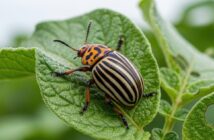High and consistent on-farm yields from a hard feed winter wheat variety could make it well worth considering by Scottish growers, a West Fife seed grower is suggesting.
According to Robbie Brewster of Messrs Alex Brewster, Kirkton Farm, Culross, growing a higher-yielding hard Group 4 winter wheat could be a more attractive option than a lower-yielding soft wheat, if growers are not achieving a soft wheat premium.
Farming around 320 hectares (800 acres) in total on medium loam soil, he grows 120 hectares (300 acres) of winter wheat, along with winter and spring barley, spring beans and potatoes.
“Historically, hard wheats have outyielded softs in Scotland,” says Mr Brewster, “but people have stayed away from them.
“Yield is a big part of creating margin. If you’re growing a variety with low yield, to get the same margin you either have lower growing costs or achieve a better price. If it’s lower-yielding and the growing costs are similar, why would you grow soft wheats, because currently we receive no premium from growing them?”
Good demand for all wheats
Mr Brewster says growers should check with their buyer as to whether they will accept hard wheat but says there is good demand for all wheats from the feed sector.

Robbie Brewster
Looking ahead, he believes the yield gap between hard and soft wheats could increase, largely due to the limited ability in controlling septoria.
The particular hard wheat Mr Brewster has had yield success with is SY Insitor. Growing it for seed for the last three years, he says high yields from it on-farm have mirrored those seen in independent Scottish trials.
“It’s been a barn filler. Certainly an uplift in yield from the soft wheats. Our farm yields as an average have increased and SY Insitor is leading the pack. The other reason that I am encouraged to grow it is because I’m a member of Scottish Agronomy and it’s been their top-yielding variety in their trials for the last three years. I feel we’ve got to follow the science.
“To me, SY Insitor is a no-brainer. It’s a consistent performer. It was dry last year and it really did perform.
“People may say it has a weakness to yellow rust, but we can control yellow rust relatively cheaply,” he adds.
Growing a range of winter wheat varieties on the farm, Mr Brewster says SY Insitor does not want to be sown too early, so tends to sow it in the second half of September, but this allows workload to be spread.
“I can’t see the logic in not at least trying it. I’m confident that farmers will be pleased with the yield they achieve on the evidence I’ve seen, and the evidence in trials.”




